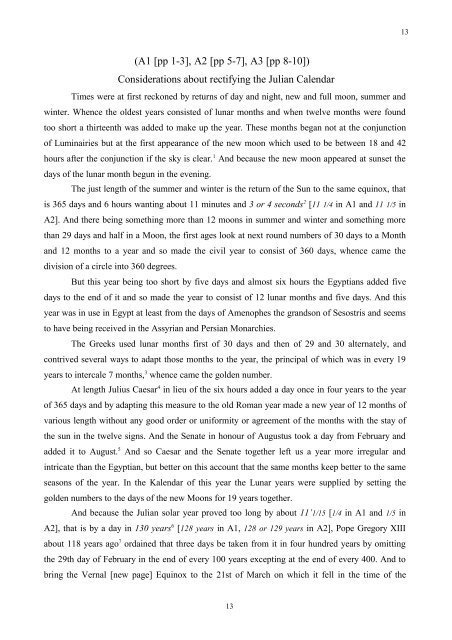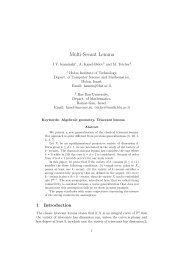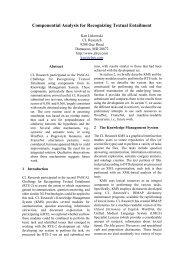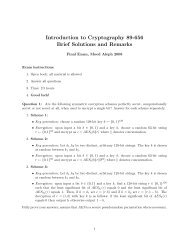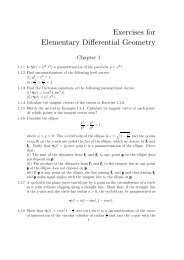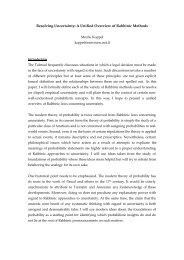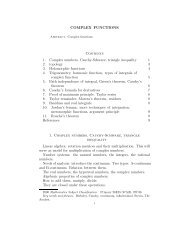Reform of the Julian Calendar as Envisioned by Isaac Newton
Reform of the Julian Calendar as Envisioned by Isaac Newton
Reform of the Julian Calendar as Envisioned by Isaac Newton
Create successful ePaper yourself
Turn your PDF publications into a flip-book with our unique Google optimized e-Paper software.
13<br />
(A1 [pp 1-3], A2 [pp 5-7], A3 [pp 8-10])<br />
Considerations about rectifying <strong>the</strong> <strong>Julian</strong> <strong>Calendar</strong><br />
Times were at first reckoned <strong>by</strong> returns <strong>of</strong> day and night, new and full moon, summer and<br />
winter. Whence <strong>the</strong> oldest years consisted <strong>of</strong> lunar months and when twelve months were found<br />
too short a thirteenth w<strong>as</strong> added to make up <strong>the</strong> year. These months began not at <strong>the</strong> conjunction<br />
<strong>of</strong> Luminairies but at <strong>the</strong> first appearance <strong>of</strong> <strong>the</strong> new moon which used to be between 18 and 42<br />
hours after <strong>the</strong> conjunction if <strong>the</strong> sky is clear. 1 And because <strong>the</strong> new moon appeared at sunset <strong>the</strong><br />
days <strong>of</strong> <strong>the</strong> lunar month begun in <strong>the</strong> evening.<br />
The just length <strong>of</strong> <strong>the</strong> summer and winter is <strong>the</strong> return <strong>of</strong> <strong>the</strong> Sun to <strong>the</strong> same equinox, that<br />
is 365 days and 6 hours wanting about 11 minutes and 3 or 4 seconds 2 [11 1/4 in A1 and 11 1/5 in<br />
A2]. And <strong>the</strong>re being something more than 12 moons in summer and winter and something more<br />
than 29 days and half in a Moon, <strong>the</strong> first ages look at next round numbers <strong>of</strong> 30 days to a Month<br />
and 12 months to a year and so made <strong>the</strong> civil year to consist <strong>of</strong> 360 days, whence came <strong>the</strong><br />
division <strong>of</strong> a circle into 360 degrees.<br />
But this year being too short <strong>by</strong> five days and almost six hours <strong>the</strong> Egyptians added five<br />
days to <strong>the</strong> end <strong>of</strong> it and so made <strong>the</strong> year to consist <strong>of</strong> 12 lunar months and five days. And this<br />
year w<strong>as</strong> in use in Egypt at le<strong>as</strong>t from <strong>the</strong> days <strong>of</strong> Amenophes <strong>the</strong> grandson <strong>of</strong> Sesostris and seems<br />
to have being received in <strong>the</strong> Assyrian and Persian Monarchies.<br />
The Greeks used lunar months first <strong>of</strong> 30 days and <strong>the</strong>n <strong>of</strong> 29 and 30 alternately, and<br />
contrived several ways to adapt those months to <strong>the</strong> year, <strong>the</strong> principal <strong>of</strong> which w<strong>as</strong> in every 19<br />
years to intercale 7 months, 3 whence came <strong>the</strong> golden number.<br />
At length Julius Caesar 4 in lieu <strong>of</strong> <strong>the</strong> six hours added a day once in four years to <strong>the</strong> year<br />
<strong>of</strong> 365 days and <strong>by</strong> adapting this me<strong>as</strong>ure to <strong>the</strong> old Roman year made a new year <strong>of</strong> 12 months <strong>of</strong><br />
various length without any good order or uniformity or agreement <strong>of</strong> <strong>the</strong> months with <strong>the</strong> stay <strong>of</strong><br />
<strong>the</strong> sun in <strong>the</strong> twelve signs. And <strong>the</strong> Senate in honour <strong>of</strong> Augustus took a day from February and<br />
added it to August. 5 And so Caesar and <strong>the</strong> Senate toge<strong>the</strong>r left us a year more irregular and<br />
intricate than <strong>the</strong> Egyptian, but better on this account that <strong>the</strong> same months keep better to <strong>the</strong> same<br />
se<strong>as</strong>ons <strong>of</strong> <strong>the</strong> year. In <strong>the</strong> Kalendar <strong>of</strong> this year <strong>the</strong> Lunar years were supplied <strong>by</strong> setting <strong>the</strong><br />
golden numbers to <strong>the</strong> days <strong>of</strong> <strong>the</strong> new Moons for 19 years toge<strong>the</strong>r.<br />
And because <strong>the</strong> <strong>Julian</strong> solar year proved too long <strong>by</strong> about 11’1/15 [1/4 in A1 and 1/5 in<br />
A2], that is <strong>by</strong> a day in 130 years 6 [128 years in A1, 128 or 129 years in A2], Pope Gregory XIII<br />
about 118 years ago 7 ordained that three days be taken from it in four hundred years <strong>by</strong> omitting<br />
<strong>the</strong> 29th day <strong>of</strong> February in <strong>the</strong> end <strong>of</strong> every 100 years excepting at <strong>the</strong> end <strong>of</strong> every 400. And to<br />
bring <strong>the</strong> Vernal [new page] Equinox to <strong>the</strong> 21st <strong>of</strong> March on which it fell in <strong>the</strong> time <strong>of</strong> <strong>the</strong><br />
13


